Are you ready to transform your outdoor space into a personal paradise? Whether you have a sprawling garden, a cozy courtyard, or a modest balcony, the possibilities for your dream yard are endless. In this listicle, we present 24 inspiring landscaping design ideas that cater to every taste and style. From lush, secret gardens to sleek, modern spaces, these concepts will not only beautify your surroundings but also enhance your quality of life. Expect to discover innovative planting schemes, creative hardscaping options, and functional design elements that can turn your outdoor area into an oasis. Dive in and explore the artistic potential waiting just outside your door!
Transform your space with vibrant flower beds and thoughtful landscaping design elements
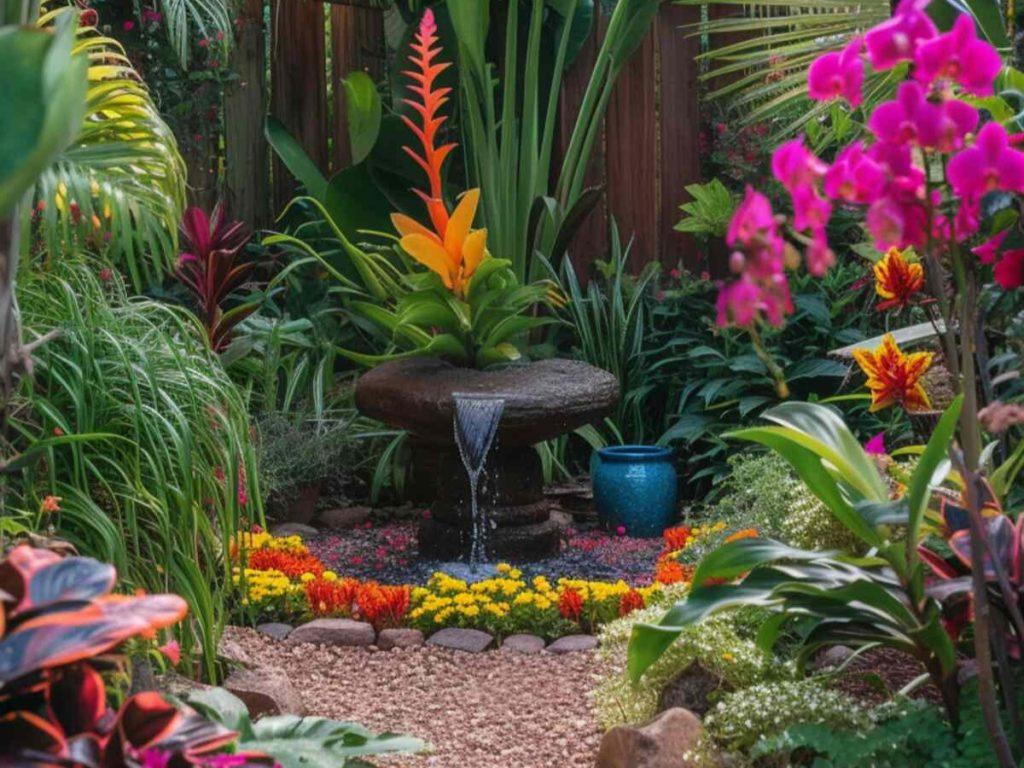
Creating vibrant flower beds can transform the overall aesthetic of your yard, offering a burst of color that attracts attention and elevates the mood. To achieve a stunning floral display, consider mixing a variety of annuals and perennials, providing continuous blooms throughout the seasons. Incorporate edging materials, such as stone or wood, to define spaces while adding structure to the design. Layering plants by height creates visual interest, while complementary color themes can guide the eye across the landscape, enhancing its visual appeal.
To further enrich your outdoor space, think about integrating thoughtful landscaping design elements like decorative pathways and seating areas. Paths can be created using materials such as gravel, flagstone, or interlocking pavers, leading visitors through your lush garden. Incorporating garden art or focal points like sculptures and water features can serve as captivating centerpieces. This interplay of design not only enhances functionality but also nurtures a serene atmosphere. For design inspiration, visit websites like houzz.com to explore various landscaping styles and ideas that can infuse your yard with personalized charm.
Create inviting pathways using natural stones in your landscaping design
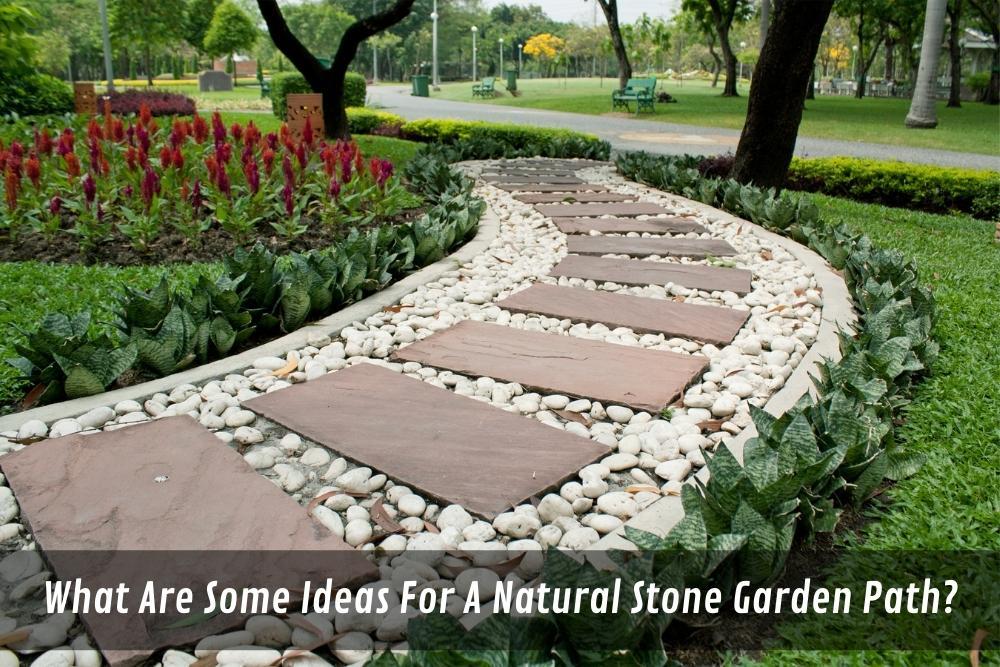
Incorporating natural stones into your landscaping not only enhances the aesthetic appeal of your outdoor space but also provides a sustainable pathway that harmonizes with the environment. Flagstones, river rocks, and pebbles can be brilliantly arranged to form stunning walkways that guide visitors through your garden. You can create winding paths that evoke curiosity and invite exploration, giving each segment of your yard a unique flavor. Consider mixing smooth river stones with irregular flagstones for an eclectic look that adds texture and interest. When choosing what stone to use, keep in mind the colors and materials present in your existing landscape to ensure a cohesive design.
In addition to their visual appeal, stone pathways can be incredibly functional. They provide stability and reduce erosion on slopes, and by arranging stones in a way that promotes drainage, you can avoid puddling and muddy spots. You might opt for a labyrinth of stones surrounded by native plants to create a serene space for contemplation, or a simple straight path flanked by lavender or other fragrant flowers to guide you to a serene seating area. Additionally, you can enhance your pathways with solar-powered garden lights, which not only illuminate the path at night but also add an extra dimension of charm. For more inspiration on using natural stones in landscaping, visit Gardenista for in-depth articles and stunning visuals on stone garden designs.
Explore zen gardens for a tranquil touch in your landscaping design
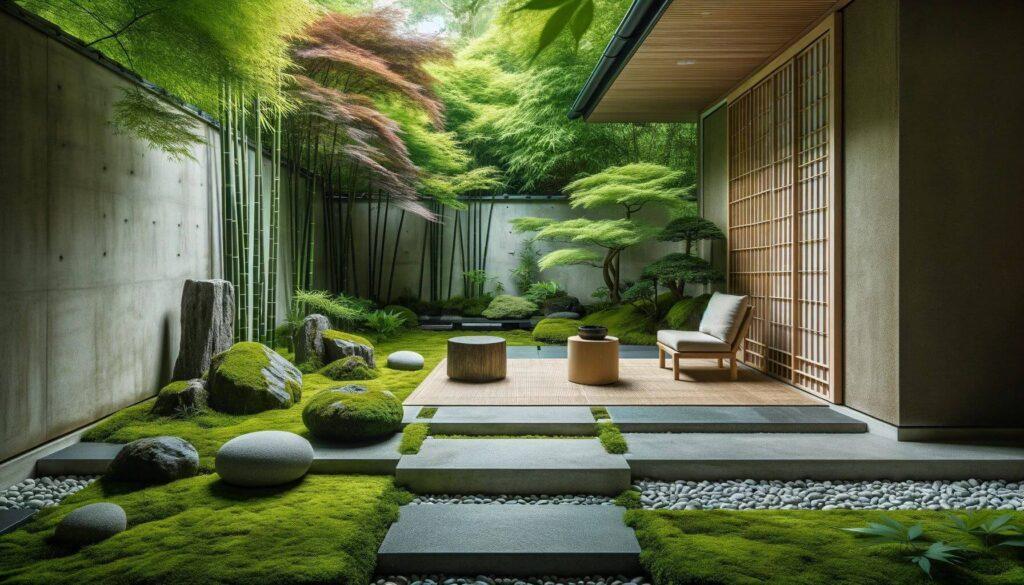
Create a serene atmosphere in your outdoor space by incorporating zen gardens into your landscaping design. Known for their minimalist aesthetic, these gardens emphasize harmony, balance, and tranquility. Use elements like gravel, sand, and stones to mimic the flowing shapes of water, while carefully placed plants and moss bring a pop of color and life. Consider integrating Japanese maples or bamboo to add a natural touch that complements the overall peace of your garden.
Enhance the immersive experience by adding features that encourage reflection and mindfulness. Incorporate stepping stones or pathways that guide visitors through the garden, allowing them to experience each section deliberately. You might also want to include a small water feature, such as a pond or a trickling fountain, to introduce the soothing sound of water, further elevating the calming ambiance. Lastly, include seating options like a simple wooden bench or a stone meditation platform, allowing for a peaceful retreat in your own yard. For more inspiration on designing your zen garden, check out Gardenista for ideas and resources.
Embrace native plants for sustainable landscaping design that supports local wildlife
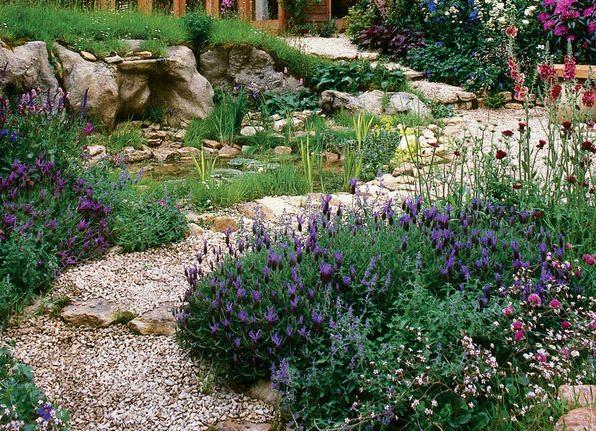
Transforming your yard into a vibrant ecosystem begins with the careful selection of native plants. These flora not only thrive in the local climate but also provide essential habitat and food for various local wildlife, from whimsical butterflies to industrious bees. By integrating native grasses, wildflowers, and shrubs, you create a landscape that blossoms with color while ensuring your garden acts as a refuge for pollinators and birds. Popular choices such as cone flowers, milkweeds, and hummingbird sage offer aesthetic beauty while serving key roles in sustaining the local ecosystem.
Incorporating native plants into your landscaping design can be as simple as creating dedicated zones or layering them in existing flower beds. Consider planting in drifts or clusters to mimic their natural growth patterns, enhancing visual impact while promoting biodiversity. Additionally, leaving some areas of your garden a little wild can encourage wildlife to visit. A compost area, a small pollinator garden, or even a rain garden can significantly enhance your outdoor space’s ecological health. For tips and insights on choosing the right native plants for your region, explore resources available at audubon.org.
Incorporate raised garden beds for a modern landscaping design aesthetic
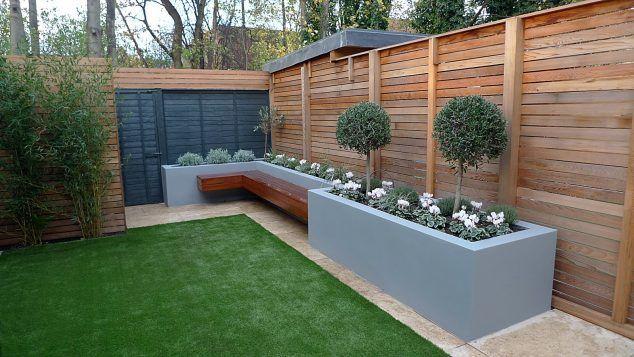
For a sleek and contemporary landscaping design, consider integrating raised garden beds into your outdoor space. These elevated structures not only enhance visual appeal but also provide numerous practical benefits. You can choose from various materials such as wood, stone, or metal, each offering a distinctive look to complement your home’s architecture. By arranging the beds in geometric shapes or staggered heights, you can create a dynamic layout that draws the eye and adds dimension to your garden. Additionally, raised beds improve soil drainage and allow for better control over soil quality, making gardening easier and more accessible.
To maintain the clean lines associated with modern design, opt for minimalist plant selections that focus on bold foliage and vibrant blooms. Consider using a monochromatic color scheme or contrasting colors to create visual interest while keeping the overall look sophisticated. Incorporate features such as integrated seating areas or decorative gravel pathways that direct attention to your raised garden beds. By blending functionality with aesthetic appeal, you create a seamless transition between nature and architecture. For ideas on styling your raised beds, check out resources from Houzz for innovative designs and inspiration.
Use decorative gravel for an elegant twist in your landscaping design
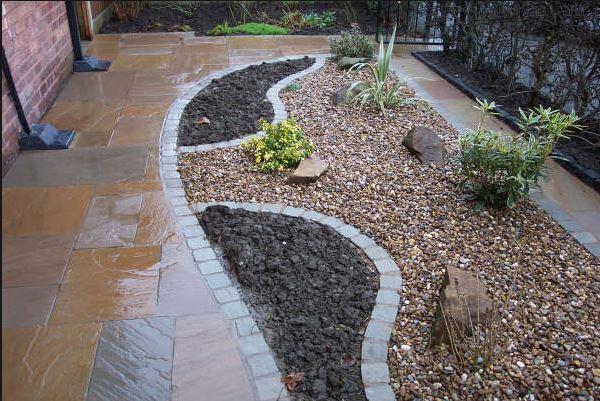
Incorporating decorative gravel into your landscaping can elevate the aesthetics of your outdoor space while providing practical benefits. This versatile material comes in various sizes, colors, and textures, allowing you to create unique patterns and contrasts that draw the eye. Consider using light-colored stones to create a bright, airy feel, or opt for dark pebbles to impart a more sophisticated, modern look. By layering gravel with other elements like plants or timber, you can achieve a multi-dimensional effect that enhances your garden’s overall design.
Gravel can also serve as a fantastic ground cover, helping to suppress weeds and reduce maintenance efforts. Whether you choose to outline paths, create a zen garden, or even add a gravel patio, the design possibilities are virtually endless. Pair your decorative gravel with native plants, decorative boulders, or even string lights to craft a serene environment perfect for relaxation or entertaining. For more inspiration, check out Garden Design for innovative ideas to make gravel a stunning focal point in your yard.
Introduce water features to enhance serenity in your landscaping design
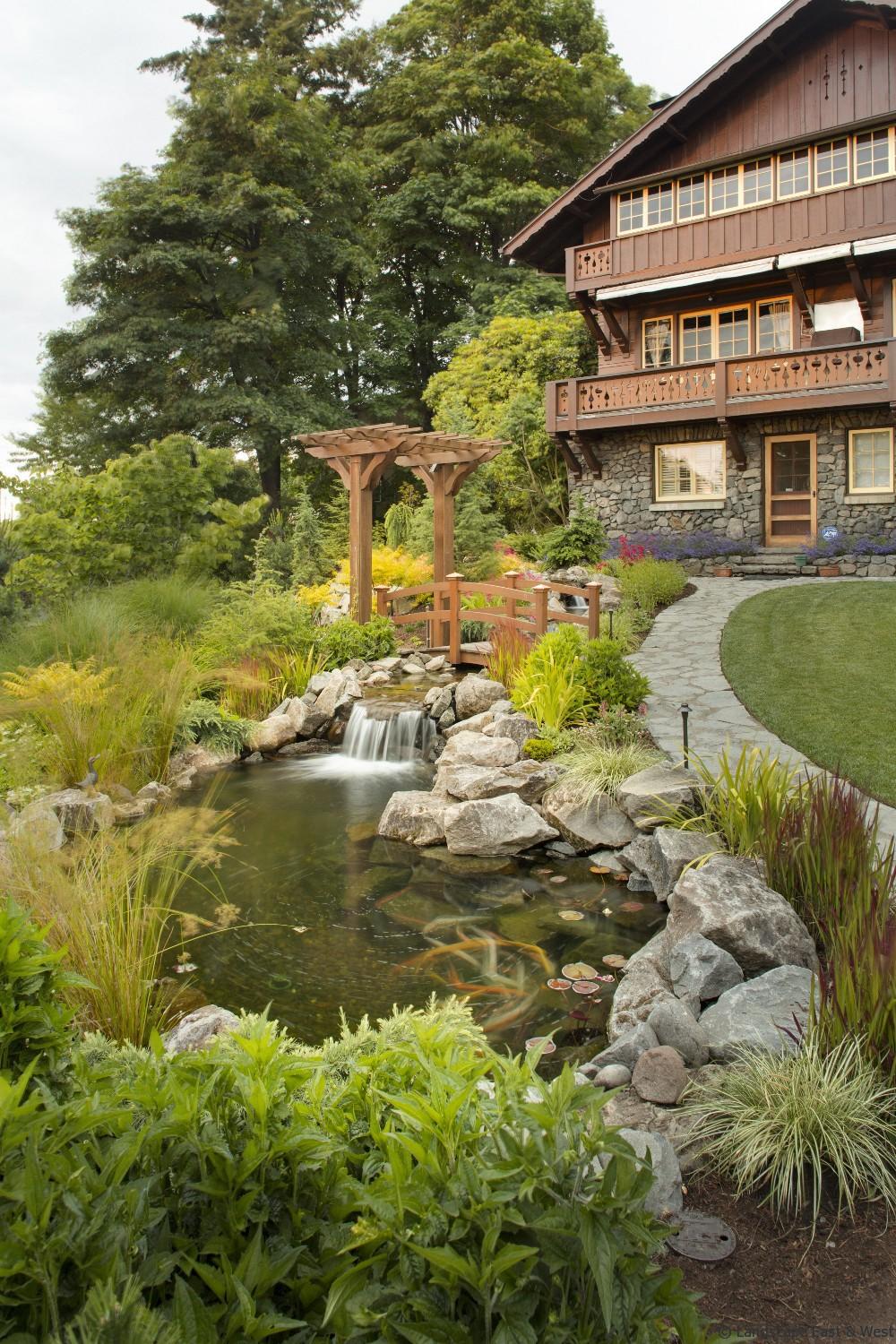
Incorporating water features into your landscaping design can significantly enhance the tranquility of your outdoor space. The soothing sounds of flowing water can serve as a natural stress reliever, creating a peaceful oasis right in your backyard. Here are some ideas to consider:
- Waterfalls: Create a stunning waterfall that cascades over rocks, diving into a pond or small pool below. This not only acts as a focal point but also draws in birds and other wildlife, enriching your garden’s ecosystem.
- Ponds: A pond can serve various purposes, from a serene sanctuary for fish to a natural gathering spot for family and friends. Surround it with ornamental plants and comfortable seating to create a perfect retreat.
- Fountains: From classical designs to modern aesthetics, fountains can fit any landscaping style. The gentle splashes can be incredibly calming and can be designed to operate on recycled water for a sustainable option.
- Streams: Mimic nature by incorporating a winding stream that flows through your garden. Use smooth stones and native plants along the banks to enhance the natural look while maintaining a serene ambiance.
To truly capture the essence of serenity in your design, consider the placement and design of your water feature. Dimensions and sound levels are crucial; a small trickling fountain may offer a softer backdrop compared to the robust sound of a waterfall. Here’s a quick reference table to help you decide:
| Water Feature | Sound Level | Best For |
|---|---|---|
| Fountain | Soft | Small spaces, patios |
| Pond | Moderate | Relaxing retreats |
| Waterfall | Loud | Statement features |
| Stream | Varies | Natural landscaping |
Explore more ideas on how to create a serene landscape at houzz.com. With the right water features, you can transform your yard into an inviting haven that calms the mind and entices the spirit.
Design an outdoor kitchen for a functional and stylish landscaping design
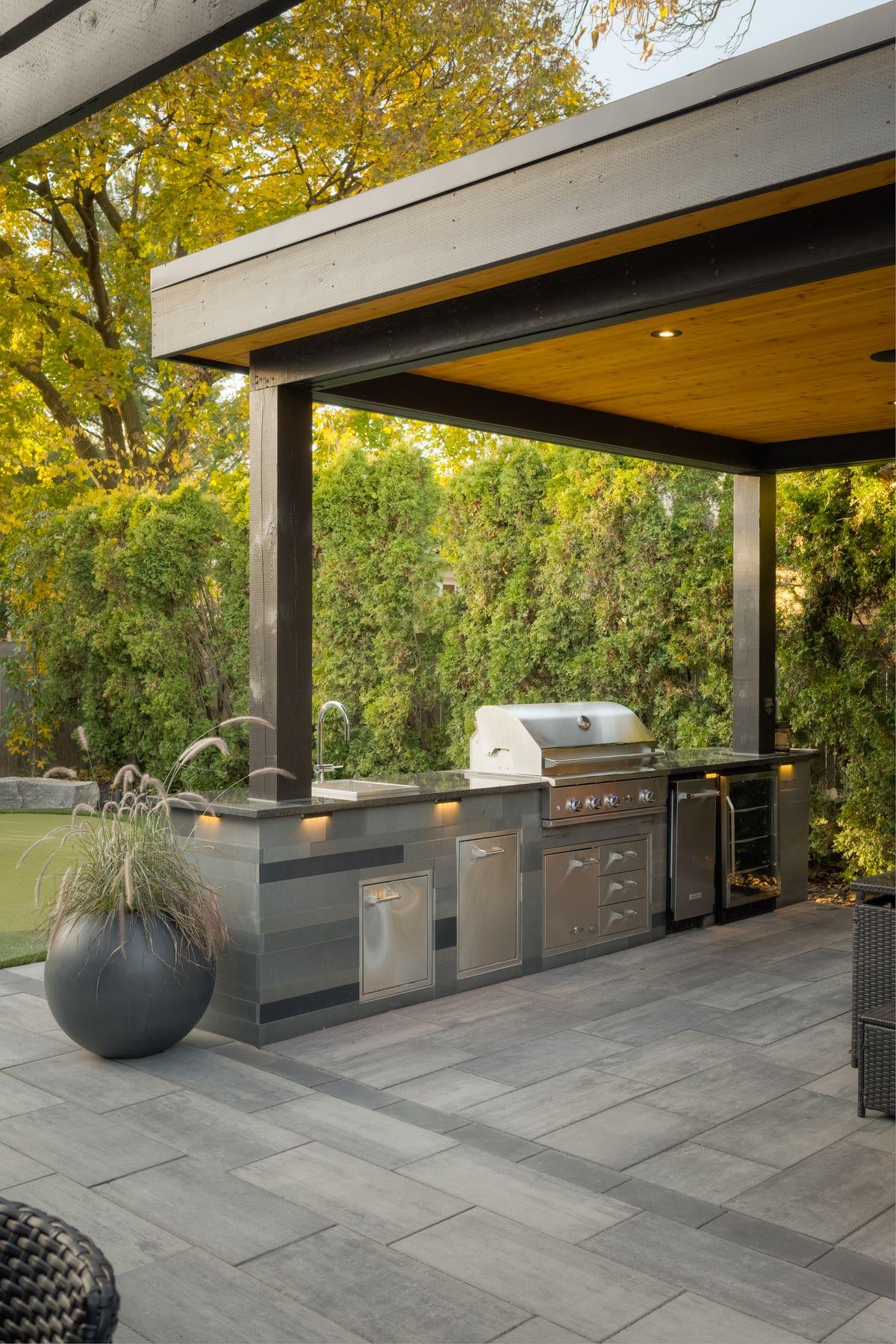
Functional and Stylish Outdoor Kitchen Ideas
When designing an outdoor kitchen, consider integrating it seamlessly into your landscaping to enhance both functionality and aesthetics. Start by choosing durable materials that can withstand the elements; stainless steel appliances, granite countertops, and stone backsplashes are excellent choices that marry beauty with resilience. You can elevate your kitchen’s appeal by incorporating smart design elements like built-in seating, a fire pit, or a bar area. Arrange these elements to promote smooth traffic flow, keeping dining areas close to cooking spaces for convenient serving.
Next, think about the surrounding landscaping that complements your outdoor kitchen’s vibe. Incorporate vertical gardens or potted plants to soften hard surfaces and introduce vibrant colors. Consider a pergola or an awning for shade and comfort, while adding mood lighting with string lights or recessed fixtures to create an inviting atmosphere for evening gatherings. To inspire your design, explore platforms like Houzz for innovative ideas that blend style and function, turning your backyard into a culinary oasis.
Experiment with vertical gardens to maximize space in your landscaping design
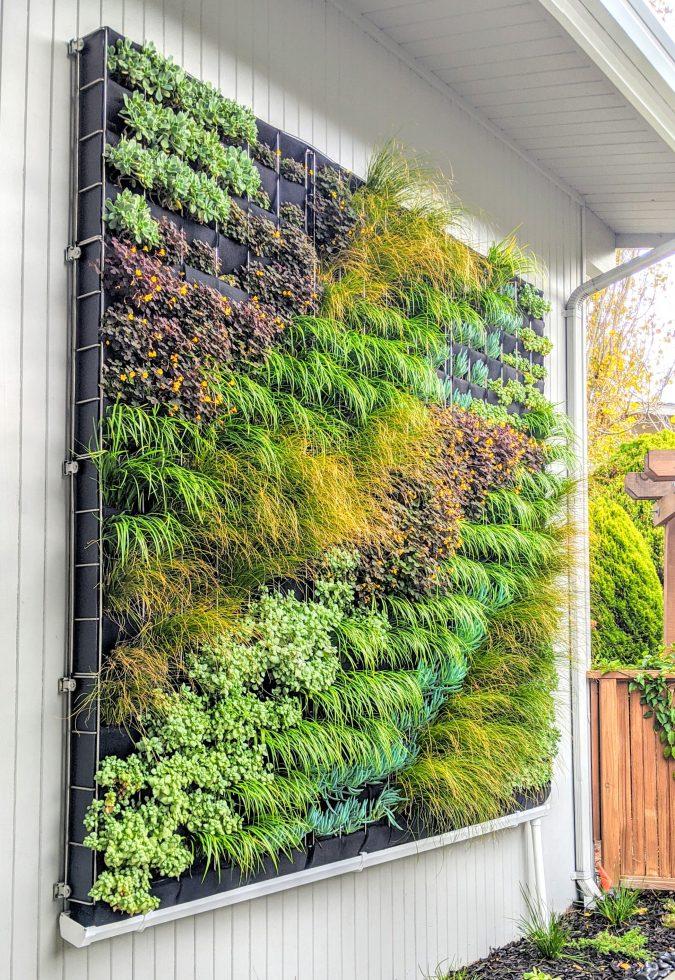
Transforming your outdoor space into a verdant retreat can be as simple as going vertical. Vertical gardens not only make a stunning visual statement but also allow you to maximize limited space while enhancing air quality. You can create your own edible garden on a wall by installing trellises or wall-mounted planters. Consider using a variety of herbs, flowers, and vining plants to add color and function. Here are a few ideas to help you get started:
- Living Wall Planters: These vertical frameworks integrate planters where flowers and herbs can thrive.
- Vertical Pallet Garden: Repurpose wooden pallets into a frame for growing vegetables or small flowering plants.
- Hanging Ladder Garden: Use an old wooden ladder to create interesting tiers for your plants, showcasing cascading foliage.
When designing your vertical garden, think about incorporating varied textures and colors for a dynamic effect. For those who appreciate a more structured approach, opt for modular planting systems that can easily be installed on any exterior wall or fence. These systems also allow for easy maintenance and healthy growth owing to their efficient water drainage. Here’s a quick overview of suitable plants for different vertical garden types:
| Type of Garden | Best Plants |
|---|---|
| Herb Garden | Basil, Mint, Thyme |
| Flowering Garden | Petunias, Ferns, Trailing Vines |
| Vegetable Wall | Lettuce, Tomatoes, Strawberries |
With endless possibilities and an eco-friendly focus, a vertical garden can be both inspiring and practical. Look for more ideas and inspiration on The Spruce.
Implement unique sculptures and art pieces to curate personal landscaping design
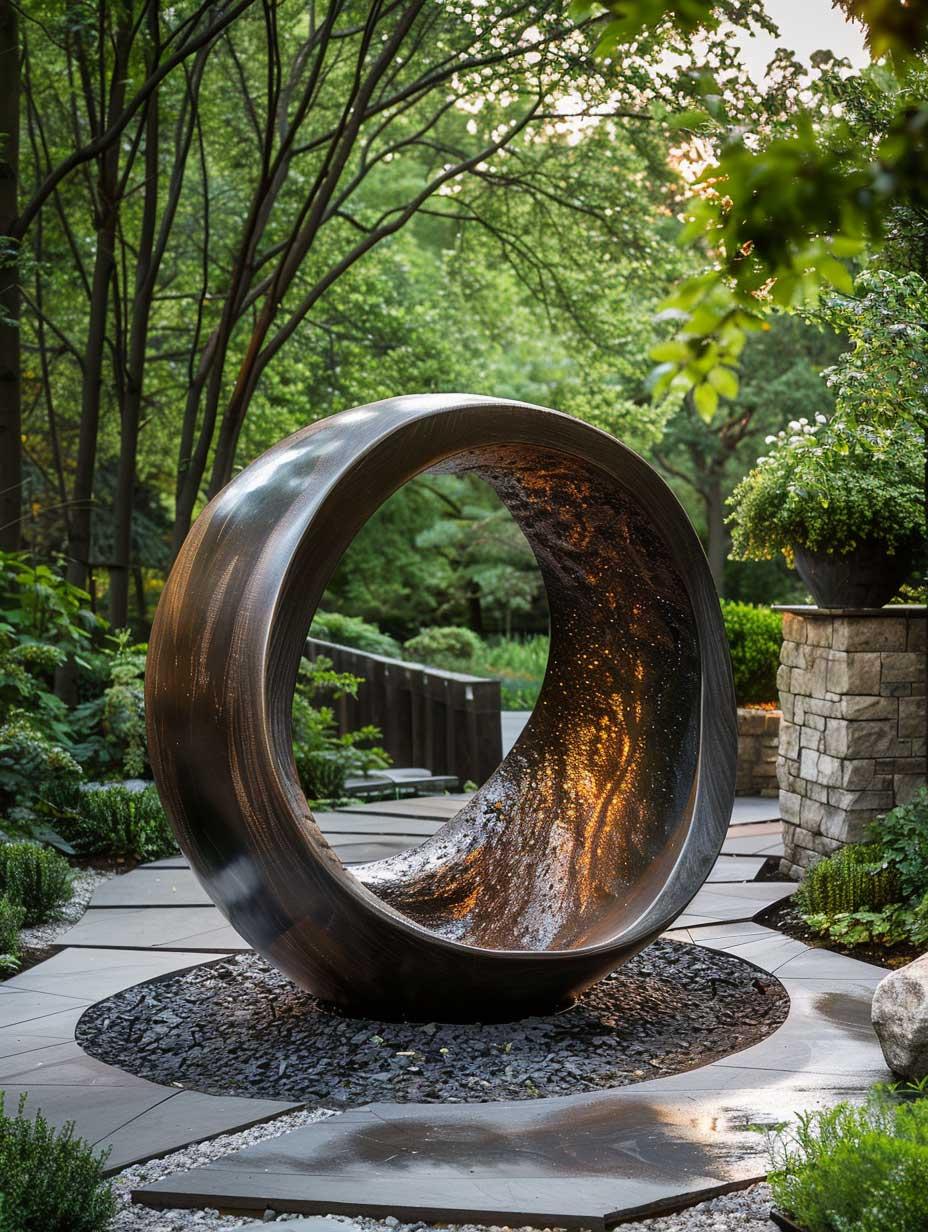
Transforming your yard can be as simple as incorporating unique sculptures and art pieces that reflect your personality and style. Statues, abstract art, or even garden installations can serve as stunning focal points that attract attention and kickstart conversations. Think of integrating pieces that harmonize with your natural surroundings, such as a stone sculpture that blends seamlessly with lush greenery or vibrant glass art that pops against a monochromatic landscape. Consider sourcing local artists or artisans to commission one-of-a-kind pieces that resonate with your vision, adding both character and a personal touch to your garden.
Moreover, the positioning of your art is crucial for maximizing its impact. Strategically place sculptures along pathways or near seating areas to guide visitors through your outdoor space while offering inspiring views. A thoughtfully designed layout not only enhances aesthetics but also encourages exploration. You can even create a designated art nook with benches that invite relaxation amidst your curated artworks. Adding lighting features can further elevate the ambiance, illuminating your sculptures at night, showcasing their textures and colors. For additional inspiration, check out the artistic ideas available at houzz.com.
Use edibles in your landscaping design for beauty and functionality
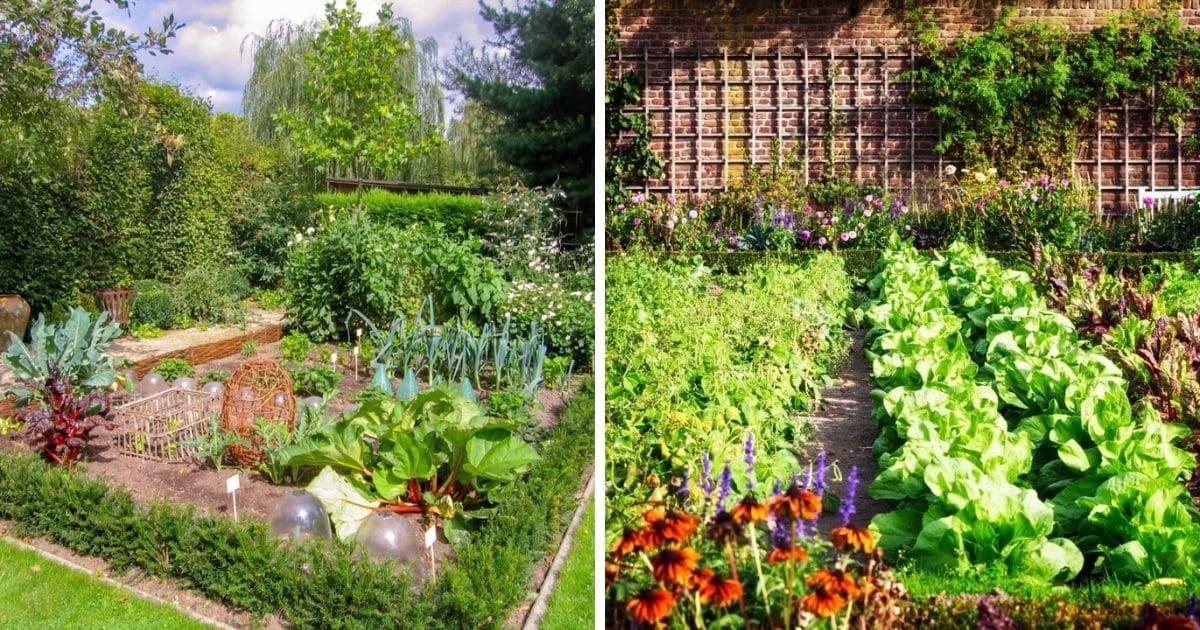
Incorporating edible plants into your landscaping not only enhances the visual appeal of your yard but also adds a practical dimension to your outdoor space. Imagine a serene garden path flanked by vibrant raspberry bushes, their delicate foliage weaving in and out of your design. Not only do they bear delicious fruits, but they also offer stunning clusters of flowers in spring. Here are some suggestions of edible plants that can blend seamlessly into your landscape:
- Fruit Trees: Apple, cherry, and pear trees serve as beautiful focal points while providing shade and sweet harvests.
- Herb Gardens: Create borders with aromatic herbs like lavender or rosemary that are both fragrant and useful in the kitchen.
- Vegetable Patches: Raised beds of colorful tomatoes and lush greens can be designed to harmonize with your flower beds.
- Berry Bushes: Strawberries and blueberries bring bursts of color and can efficiently fill in spaces with their lush greenery.
To maximize both beauty and efficiency, consider using vertical gardening techniques for climbing plants like peas or cucumbers. Not only do these types of plants require less ground space, but they can also create intriguing layers in your landscaping design. A trellis adorned with flowering climbing beans can transform a simple fence into a charming garden feature. Plus, they are an excellent conversation starter! For more inspiration, check out Better Homes & Gardens for innovative ideas that blur the lines between aesthetics and functionality.
Opt for a cottage garden style to evoke charm in your landscaping design
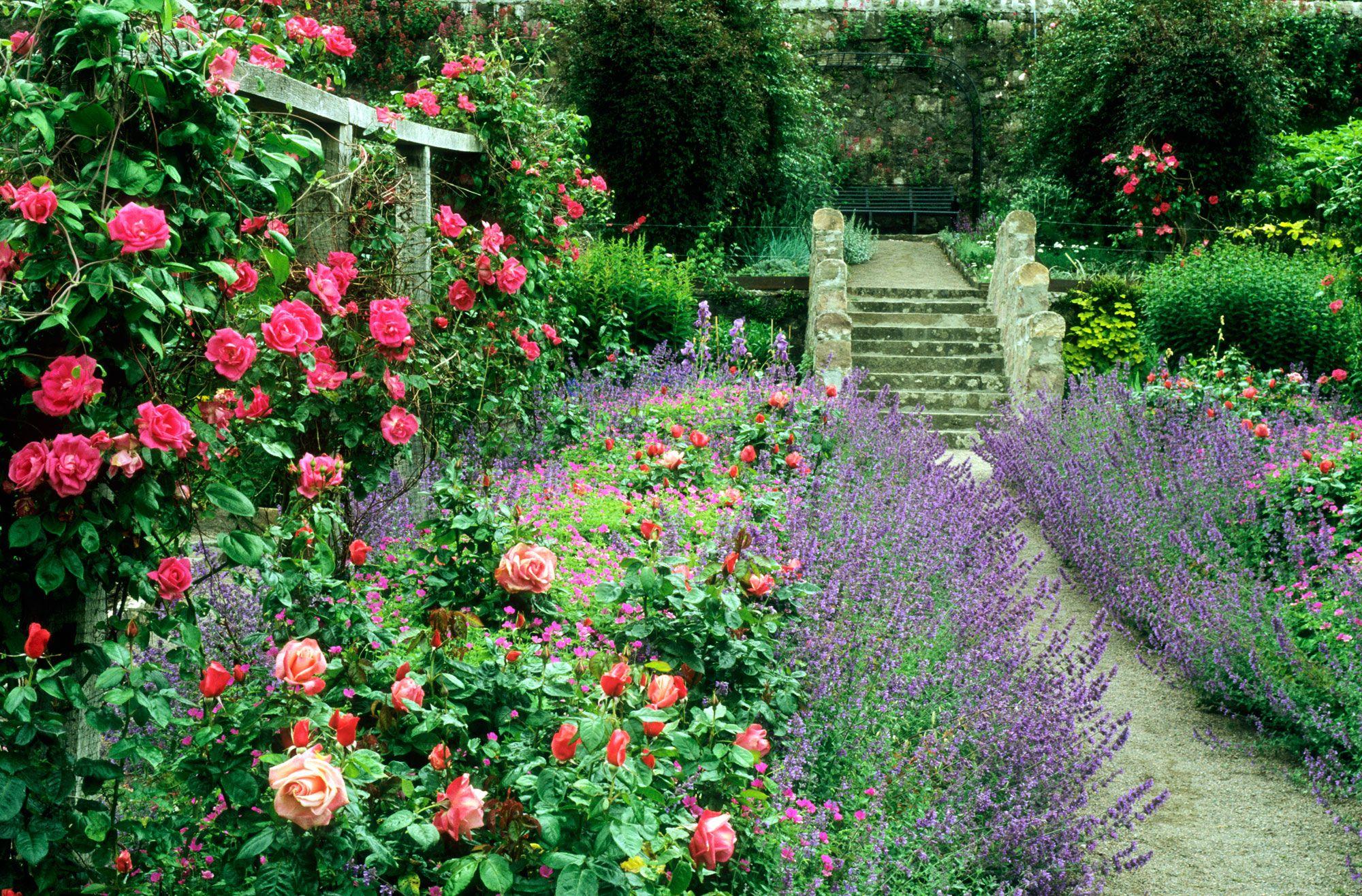
Transform your outdoor space into a delightful retreat with a cottage garden style. This theme is characterized by an informal layout and a lush variety of plants that blend harmoniously to create a cozy, inviting atmosphere. Imagine pathways flanked by vibrant flowers like daisies, foxgloves, and lavender, coupled with climbing roses draping over rustic trellises. A charming stone or brick path can guide guests through a colorful maze of blooms, while whimsical garden ornaments like vintage watering cans or birdhouses add personal touches.
To enhance the charm, consider incorporating varied plant heights and textures. Mix perennials with annuals to ensure seasonal variety, and intersperse foliage plants for added depth. Here are some key elements to include in your design:
- Wildflowers: Encourage pollinators and create a naturally vibrant palette.
- Herb garden: Add fragrances and flavors with thyme, rosemary, and basil.
- Bench seating: A rustic wooden bench invites relaxation amid blooming beauty.
- Repurposed items: Use old crates or barrels as planters to enhance the rustic feel.
| Flower Type | Bloom Time | Height |
|---|---|---|
| Lavender | Summer | 24-36 inches |
| Daisies | Spring-Summer | 18-24 inches |
| Foxgloves | Late Spring | 36-48 inches |
For more inspiration on creating this enchanting style, explore various resources, including gardeners.com, where you can find expert advice on plant selection and garden design tips.
Plan a fire pit area for cozy gatherings in your landscaping design
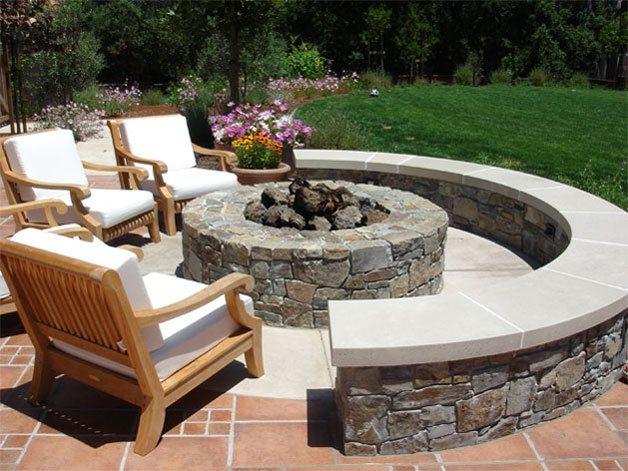
Creating a designated fire pit area not only enhances the aesthetic appeal of your yard but also provides a cozy spot for gatherings year-round. Start by selecting a central location that offers a balance between privacy and accessibility. Surround the fire pit with comfortable seating options, such as adirondack chairs, benches, or even sectional sofas that can withstand outdoor elements. To elevate the ambiance, consider incorporating soft lighting, like string lights or lanterns, which will create a warm glow as the sun sets.
To further personalize your fire pit zone, integrate natural elements that complement your landscaping design. Flower beds, ornamental grasses, or stone pathways can provide texture and color, drawing the eye toward your inviting gathering space. Think about adding a pergola or a shade sail overhead to offer protection and define the area, making it a perfect spot for day or night. Additionally, you can introduce a firewood storage solution, like a decorative log holder or built-in shelving, ensuring that your seating area remains tidy and functional. For inspiration and design ideas, visit Houzz to discover how others have crafted their own unique fire pit spaces.
Create a sensory garden with diverse textures in your landscaping design
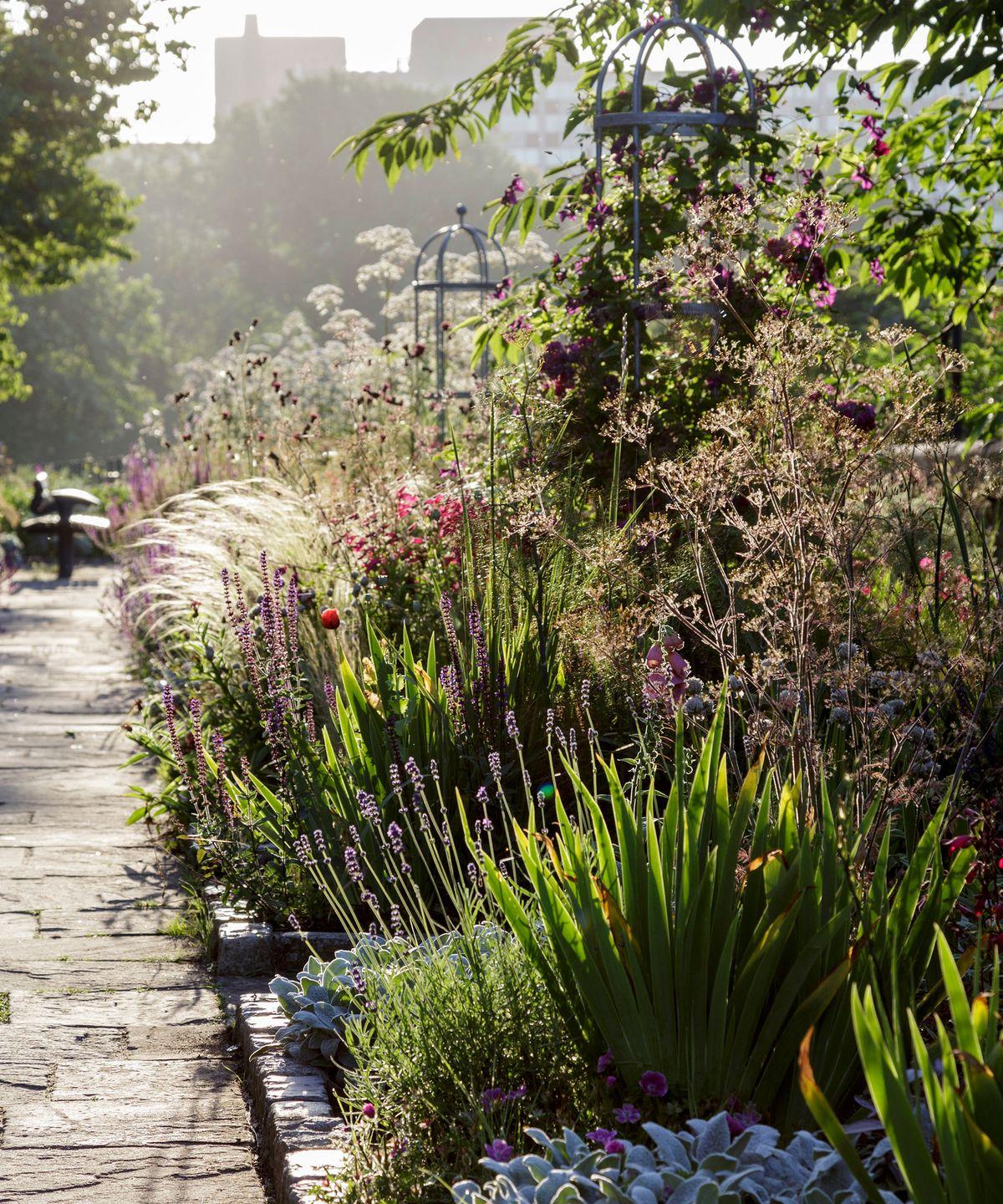
Transform your outdoor space into an enchanting sensory garden by incorporating a wealth of diverse textures. Consider using soft, fuzzy plants like lamb’s ear or thyme to offer a gentle touch, while sturdy, spiky varieties such as aloe vera or sea holly can provide a delightful contrast. Incorporate smooth river stones and rough-textured bark mulch to create a tactile journey for visitors. The harmonious blend of these elements not only beautifies your yard but also keeps the senses engaged, inviting exploration and interaction with nature.
Think about making paths through your garden using a variety of materials to enhance the sensory experience. Gravel pathways can crunch underfoot, creating a satisfying sound, while wood chips and pebbles offer different feels on bare feet. Lastly, introduce interactive features such as wind chimes, water features, and even sundials that add sound, movement, and curiosity to the environment. For more ideas on creating wonderful landscape elements, check out gardenista.com for inspiration.
Design a wildlife-friendly habitat with your landscaping design choices

Creating a garden that invites local wildlife can enhance the beauty and vibrancy of your outdoor space while supporting biodiversity. Start by incorporating native plants that require less water and maintenance, as they are well-adapted to your local environment. These plants provide essential food and shelter for pollinators, birds, and other wildlife. Consider planting a variety of flowering plants, shrubs, and trees to create different layers and habitats within your yard. Additionally, including features like berry bushes and seed-producing flowers can attract diverse species throughout the seasons.
To further enrich your wildlife-friendly space, introduce elements such as water sources and natural shelter. Install a small pond or birdbath to provide hydration for creatures, and consider adding rock piles or logs for habitat diversity. By creating a wildlife corridor—a pathway of plants or structures connecting different areas of your yard—you can facilitate movement for local fauna. avoid harmful pesticides and herbicides to promote a safe environment for all wildlife. For more information on creating an eco-friendly garden, check out Audubon.
Add colorful outdoor furniture to complement your landscaping design vision
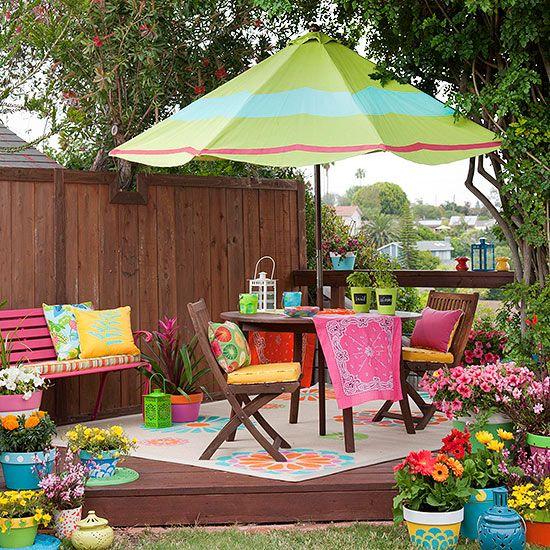
Integrating colorful outdoor furniture into your landscaping design can effortlessly enhance the overall aesthetic of your yard. Consider vibrant hues that not only pop against greenery but also echo your personal style. Whether it’s a bright red patio set or a sunny yellow hammock, such pieces invite relaxation and create focal points that draw the eye. Opt for weather-resistant materials that withstand the elements while showcasing a playful palette. Group couches and chairs in fun shapes around fire pits or scatter side tables in vibrant hues throughout your garden space to maintain a sense of cohesion amidst the vibrant chaos.
To further enhance your outdoor retreat, think about harmonizing your furniture with the surrounding flora. For instance, pair teal seating with blooming hydrangeas or introduce lemon-yellow cushions next to lavender plants. Create a beautiful visual rhythm that brings harmony to your design vision. Add elements like distinctive lighting around your furniture—think string lights or lanterns in complementary colors—to keep the atmosphere warm and inviting even as the sun sets. When choosing pieces, a great resource is Wayfair, offering an array of options to fit various styles and budgets. Additionally, a table can help organize your color selections when planning your outdoor space:
| Color | Furniture Piece | Complementary Plant |
|---|---|---|
| Teal | Outdoor Couch | Hydrangeas |
| Bright Yellow | Dining Chairs | Lavender |
| Crimson Red | Cushions | Red Roses |
Incorporate lighting features to elevate nighttime charm in your landscaping design
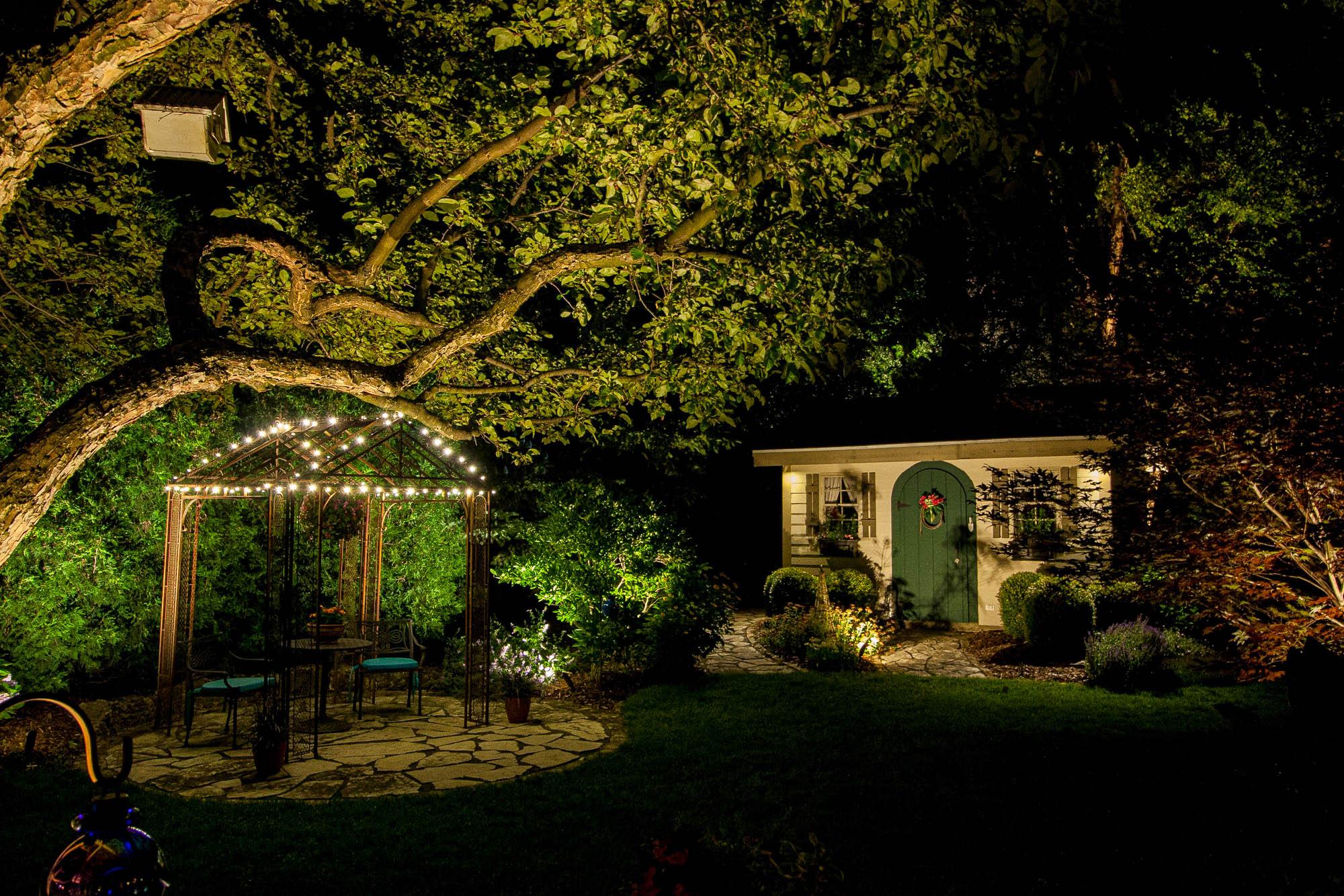
- Pathway Lighting: Illuminate walkways and garden paths with stylish solar or LED lights. Not only does this enhance safety, but it also creates a magical ambiance as light reflects off the surrounding flora.
- Uplighting Trees: Highlight the grandeur of your trees by placing uplights at their base. This technique accentuates the bark’s texture and the foliage, creating an ethereal glow that transforms your yard into a nighttime haven.
- Deck and Patio Lights: Integrate lights into your deck or patio rails for a cozy and inviting feel. String lights or recessed fixtures can warm up outdoor gatherings and create a perfect backdrop for evening socializing.
- Water Feature Illumination: If you have a pond or fountain, consider submersible lights. Illuminating water features not only brings a sparkle to the surface but also adds a tranquil sound as the water cascades in the glow.
For a more customized touch, experiment with smart lighting systems that allow you to adjust brightness and color through your smartphone. This versatility can set the perfect mood for everything from a casual family dinner to a sophisticated evening soiree. Additionally, consider using eco-friendly solar lights, which charge during the day and turn on automatically at dusk, seamlessly blending sustainability into your design.
| Lighting Feature | Effect |
|---|---|
| Pathway Lights | Guides paths while enhancing safety |
| Uplighting Trees | Creates dramatic silhouettes and highlights |
| Deck Lights | Increases ambiance for gatherings |
| Water Feature Lights | Adds tranquility and sparkle |
Create shady retreats with strategic tree planting in your landscaping design
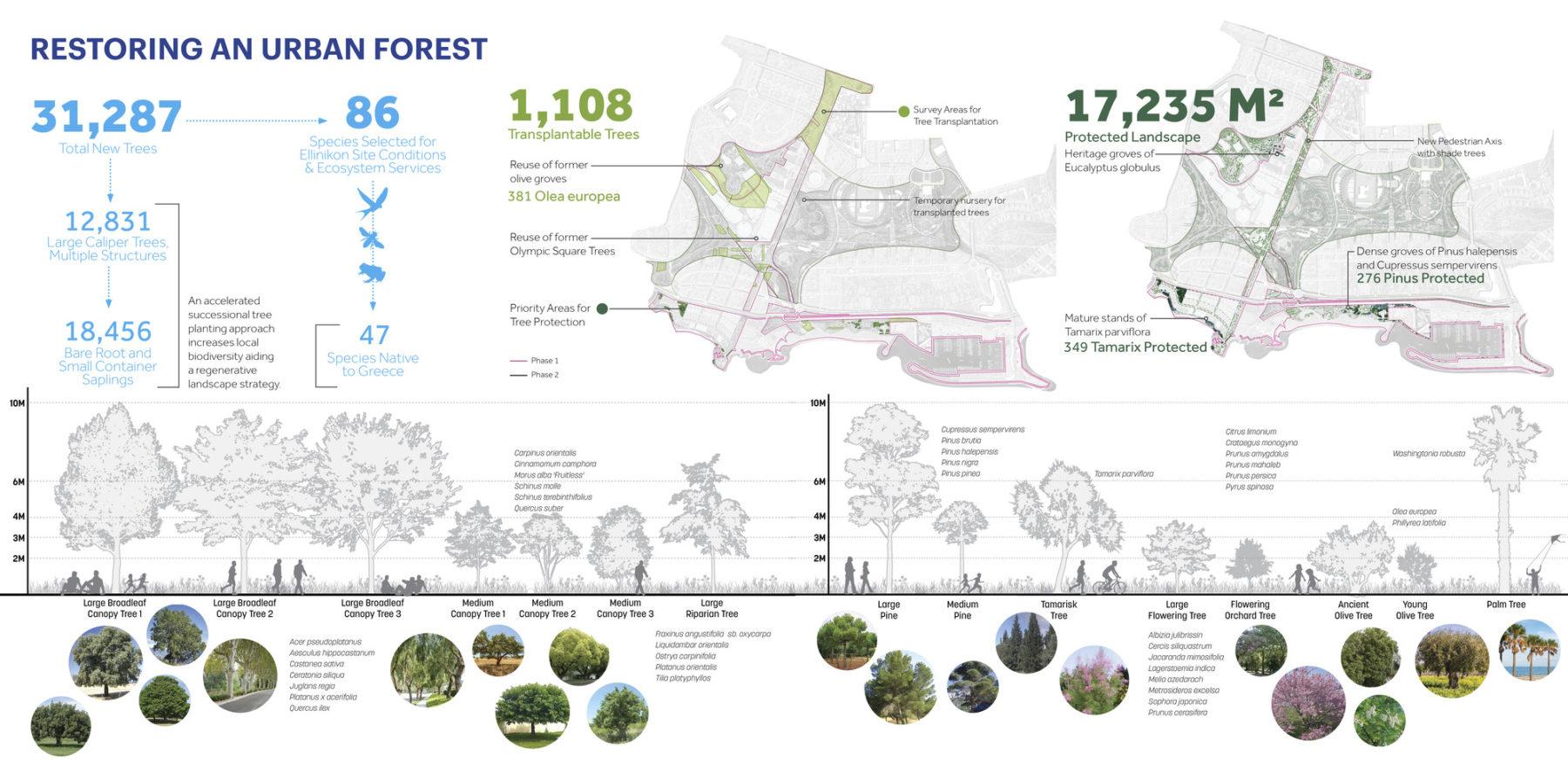
One of the most effective ways to enhance your outdoor space is by integrating well-placed trees into your landscaping design. Consider planting deciduous trees such as oaks or maples on the western side of your yard to cast cooling shade during the hot summer afternoons. Evergreens, like pines or spruces, can offer year-round privacy and shelter from harsh winds when strategically positioned around the property’s perimeter. To create an inviting atmosphere, group trees at varying heights, which not only looks aesthetically pleasing but also improves the microclimate, encouraging other plants to thrive beneath their canopy.
Additionally, think about incorporating flowering trees like cherry or dogwood that can serve as focal points within your landscape. Use their blooms to complement seasonal plantings and provide a vibrant splash of color. You can establish cozy seating areas with the help of shade from these trees, making spaces for relaxation or social gatherings. Enhance this shaded retreat by adding ground covers and low plants beneath the tree branches, creating a layered effect that feels lush and alive. For more ideas on tree selection and landscaping, check out Arbor Day.
Unify your yard using cohesive color palettes in your landscaping design
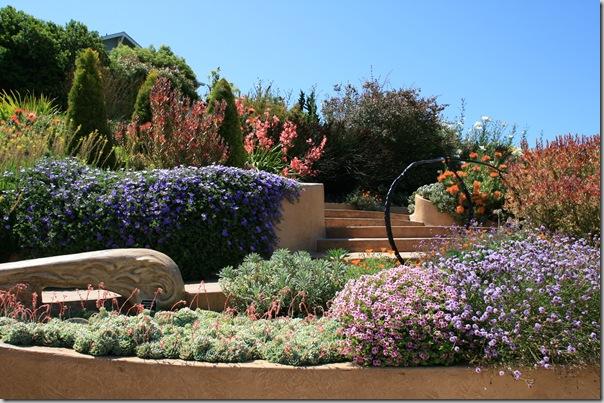
Creating a harmonious landscape begins with a well-thought-out color palette that pulls all elements of your yard together. Consider choosing a few dominant colors to dictate your plant selection, garden accessories, and hardscaping materials. For instance, if you love blues and purples, opt for flowers such as hydrangeas and lavender, complemented by gray stone pathways. This does not only enhance the visual appeal but also creates a tranquil atmosphere for relaxation and enjoyment. Use pops of contrast sparingly, like vibrant yellow planters or red garden furniture, to create focal points that draw the eye without overwhelming the senses.
To take your design to the next level, think about the interplay of colors across different seasons. Selecting year-round plantings ensures that your landscape remains cohesive, even as seasons change. Use a table to strategize which plants to use throughout the year:
| Season | Plants/Colors |
|---|---|
| Spring | Pink Tulips, Lavender |
| Summer | Bright Sunflowers, Purple Coneflowers |
| Fall | Ornamental Grasses, Marigolds |
| Winter | Evergreen Shrubs, Red Berries |
By focusing on a cohesive color scheme, you can create a stunning visual narrative that enhances your yard’s aesthetic appeal. For further inspiration on color palettes, check out this resource.
Choose drought-tolerant plants for eco-friendly landscaping design solutions
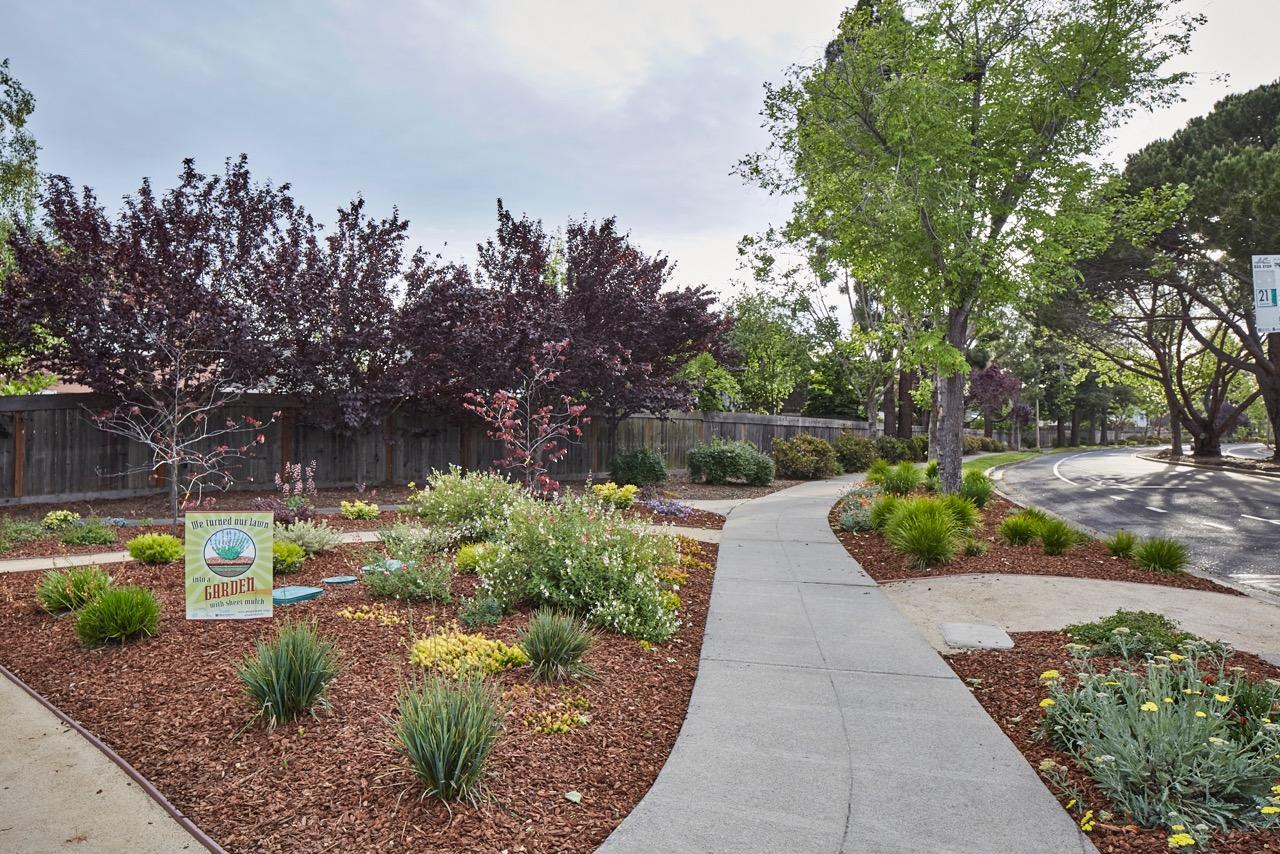
If you’re seeking sustainable solutions for your yard, incorporating drought-tolerant plants is a commendable choice. These resilient flora not only conserve precious water resources but also create a stunning focal point in your landscape. Consider a mix of native species and well-adapted non-native varieties, such as:
- Lavender: Known for its aromatic appeal and deep purple blooms.
- Agave: A sculptural plant that adds a modern touch with minimal water needs.
- Succulents: Available in various shapes and colors, perfect for adding texture.
- Yucca: Sturdily beautiful, this plant produces striking spikes and resilient foliage.
- Ironweed: A vibrant perennial that attracts pollinators while thriving in dry conditions.
To maximize the beauty and efficiency of your landscaping, group these plants according to their water needs. This technique not only simplifies maintenance but also enhances the aesthetic appeal of your yard. Here’s a quick reference table to help you choose and arrange these plants:
| Plant Name | Flowering Season | Height | Light Requirement |
|---|---|---|---|
| Lavender | Summer | 2-3 ft | Full Sun |
| Agave | Spring | 1-6 ft | Full Sun |
| Succulents | Year-round | Varies | Partial to Full Sun |
| Yucca | Summer | 3-8 ft | Full Sun |
| Ironweed | Late Summer | 3-5 ft | Full to Partial Sun |
By integrating these hardy options into your landscaping, you’ll not only create a vibrant, low-maintenance garden but also contribute positively to your environment. For more ideas and inspiration on how to cultivate a water-smart yard, visit EPA’s WaterSense program.
Design tiered gardens to utilize elevation in your landscaping design
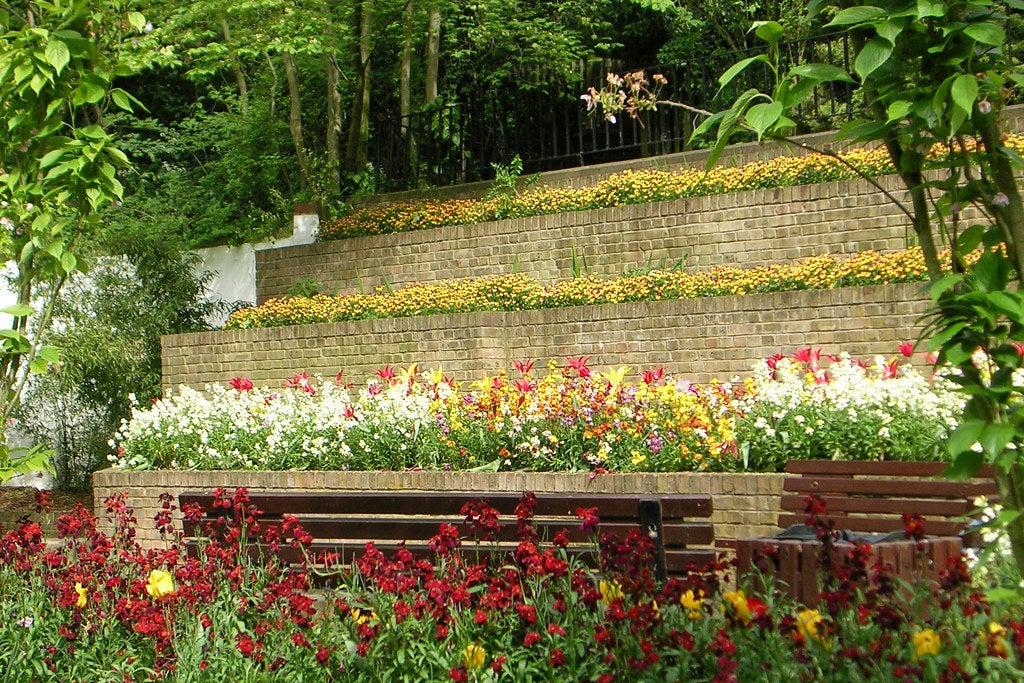
Creating tiered gardens not only adds visual interest to your yard but also maximizes the use of elevation, allowing various plant species to thrive in their ideal conditions. Consider incorporating stone retaining walls to divide each level and create a structured look, while also ensuring that water drains effectively to prevent erosion. By varying the heights, you can layer your plants, using taller shrubs and perennials on the highest tier, and vibrant flowers and ground cover plants on the lower levels. This design technique draws the eye upward, creating an illusion of depth and enhancing the natural contours of your landscape.
In addition to the aesthetic benefits, tiered gardens can serve practical purposes in your garden design. For instance, you can incorporate edible plants at different levels—imagine a raised bed with herbs and salad greens on one tier, providing easy access for harvest, while deeper-rooted vegetables like carrots and potatoes thrive below. This method not only promotes biodiversity but also allows for unique watering methods, such as drip irrigation or rain gardens that capture and utilize rainwater efficiently. Check out some creative tiered garden designs at prolandscapermagazine.com for more inspiration.
Create cozy nooks with benches to enhance your landscaping design
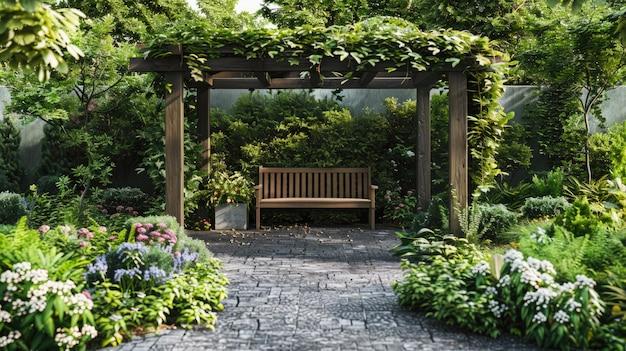
Transforming your yard into a serene escape can be achieved by incorporating thoughtfully placed benches. These charming seating areas not only serve as functional spaces to relax and enjoy the view but also act as focal points that enhance the overall aesthetics of your garden. Opt for natural materials like wood or stone to harmonize with the surrounding flora, or go for a more modern approach with metal designs that add contrast to lush landscapes. Benches tucked away beneath leafy canopies can become cozy reading spots, encouraging you to spend more time outdoors.
In addition, consider arranging benches in proximity to flower beds, fountains, or trees to create intimate gathering spaces. Pairing your benches with strategically placed potted plants or hanging gardens can introduce layers of color and texture, further enriching your landscaping design. For those looking to extend the visual appeal, adding cushions or decorative blankets can enhance comfort while adding splashes of color. Explore more ideas on outdoor living and seating arrangements at Houzz to inspire your personalized nook.
Integrate seasonal blooms to keep your landscaping design vibrant year-round
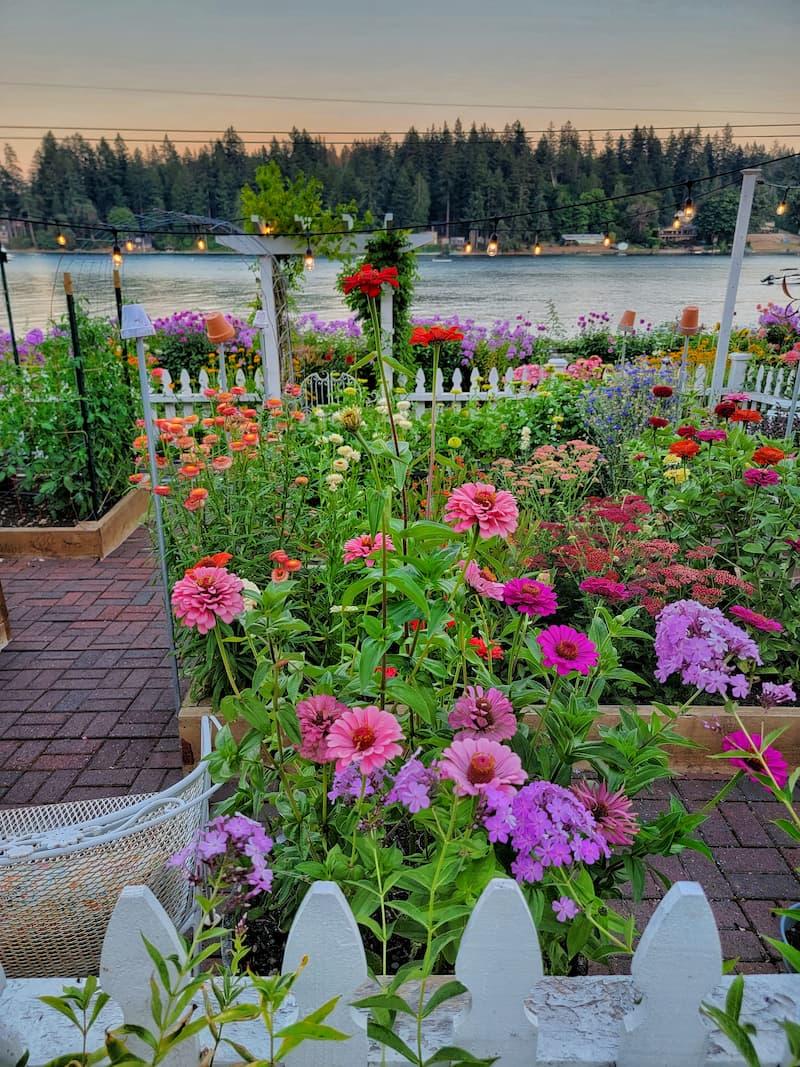
One of the most delightful ways to maintain a lively landscape is by incorporating seasonal blooms that burst with color throughout the year. By carefully selecting a mix of perennial and annual flowers, you can create a harmonious transition that dazzles every season. For spring, consider planting tulips, daffodils, and hyacinths to mark the vibrant rebirth of nature. As summer arrives, let sunflowers, zinnias, and lavender take center stage, providing bursts of joy and inviting pollinators into your garden. In the fall, mums and asters will keep the color alive, perfectly complemented by the rich tones of autumn foliage. Lastly, winter greenery such as holly, pansies, and winter jasmine will ensure that your yard remains inviting, even when snow blankets the ground.
To effectively implement this rotational flowering strategy, consider designing your garden beds with a thoughtful layout that accounts for height, texture, and bloom time. Use layering techniques to create depth; for example, place taller varieties like delphiniums or hollyhocks towards the back, with medium-sized blooms like coneflowers and peonies in the middle, and border the front with low-growing options such as lobelia and snapdragons. To keep your canvas vivid and fresh, using a seasonal planting calendar is essential. Below is a simple reference table showcasing suggested blooms by season:
| Season | Flowers |
|---|---|
| Spring | Tulips, Daffodils, Hyacinths |
| Summer | Sunflowers, Zinnias, Lavender |
| Fall | Mums, Asters |
| Winter | Holly, Pansies, Winter Jasmine |
By embracing these seasonal transitions and planning your landscape accordingly, you can create a tapestry of colors that change throughout the year. For more inspiration on seasonal planting and design techniques, check out Gardeners.com.
Use patterned paving stones for visual interest in your landscaping design
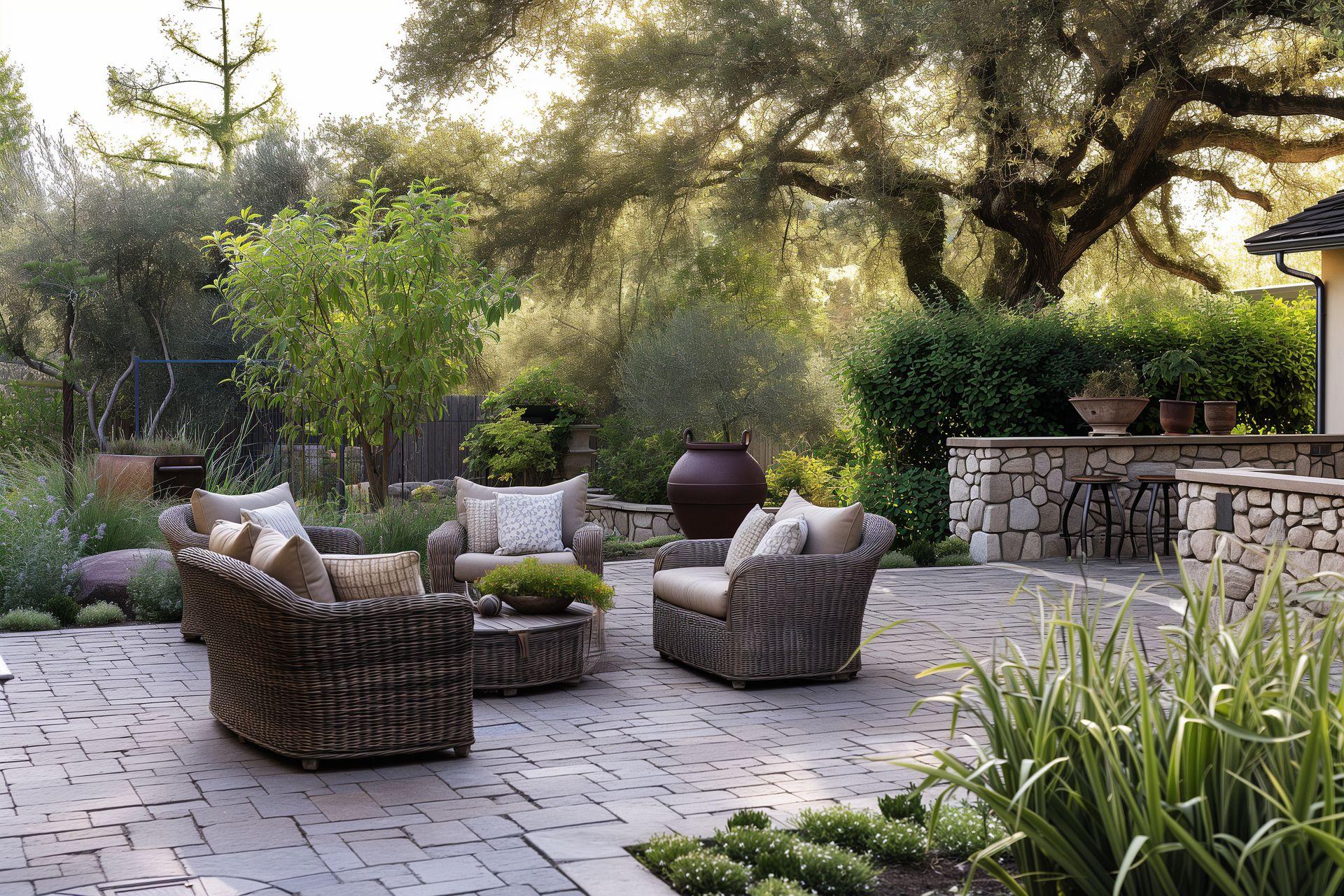
Transform your outdoor space into a captivating visual masterpiece by incorporating patterned paving stones into your landscaping design. These versatile stones not only provide a durable surface for walkways and patios but also offer an exciting backdrop for garden features. By mixing and matching varying colors and shapes, you can create intricate designs that guide visitors through your yard while drawing attention to specific areas. Consider using chevron, herringbone, or circular patterns to add depth and interest, encouraging a natural flow in your outdoor layout.
Additionally, you can enhance the beauty of your landscape with unique pathways that lead the eye from one focal point to another. Use a combination of large, bold stones with smaller, decorative pieces to achieve a striking contrast. Surround these pathways with low-growing plants or ornamental grasses for added texture and color. An effective way to showcase your design is by employing a color scheme that reflects the surrounding flora, ensuring that the paving stones tie harmoniously into the overall aesthetic of your yard. Explore more design ideas on sites like Houzz for inspiration.
The Conclusion
As we conclude our journey through these 24 inspiring landscaping design ideas, we hope you’ve found the seeds of creativity to cultivate your own dream yard. Whether you’re drawn to the tranquil charm of a rustic garden, the modern elegance of minimalist landscapes, or vibrant floral displays bursting with color, each idea offers a unique pathway to enhance your outdoor space.
Remember, landscaping is not merely about aesthetics; it’s about creating an environment that reflects your personality and invites nature into your life. So grab your gardening gloves, sketch out your vision, and let your imagination take root. Your dream yard is just a few plants, stones, or thoughtful designs away. Happy landscaping!
